Here’s A Savory Romesco Sauce Recipe That Will Play With Your Senses!
Salsa Romesco – or Romesco Sauce in English – is a classic Spanish creation hailing from the Cataluña region in the North of Spain.
It’s thick, earthy, super flavorful, and packed to the brim with umami.
Typically eaten with roasted “Calçots”, a type of spring onion, romesco sauce can also be used to dress all kinds of meat and fish, or as a delicious dipping sauce for roasted vegetables.
It’s definitely a versatile condiment that will add depth and complexity to your meals!
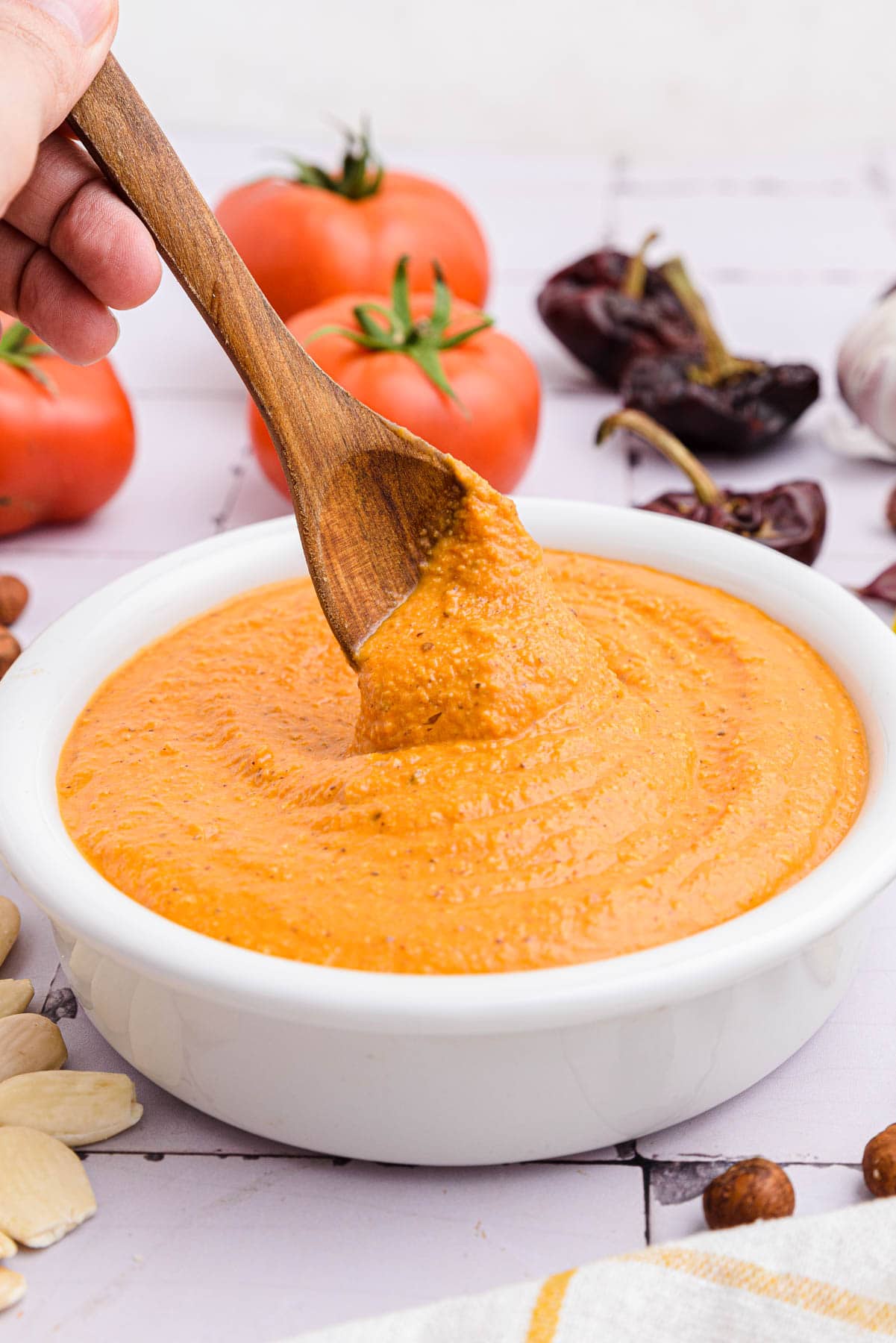
Although not traditional, Romesco sauce can also be used as a flavor enhancer for stews and many other dishes.
So don’t be shy and add a couple of spoons to your next beef stew for amazing results.
Ingredients
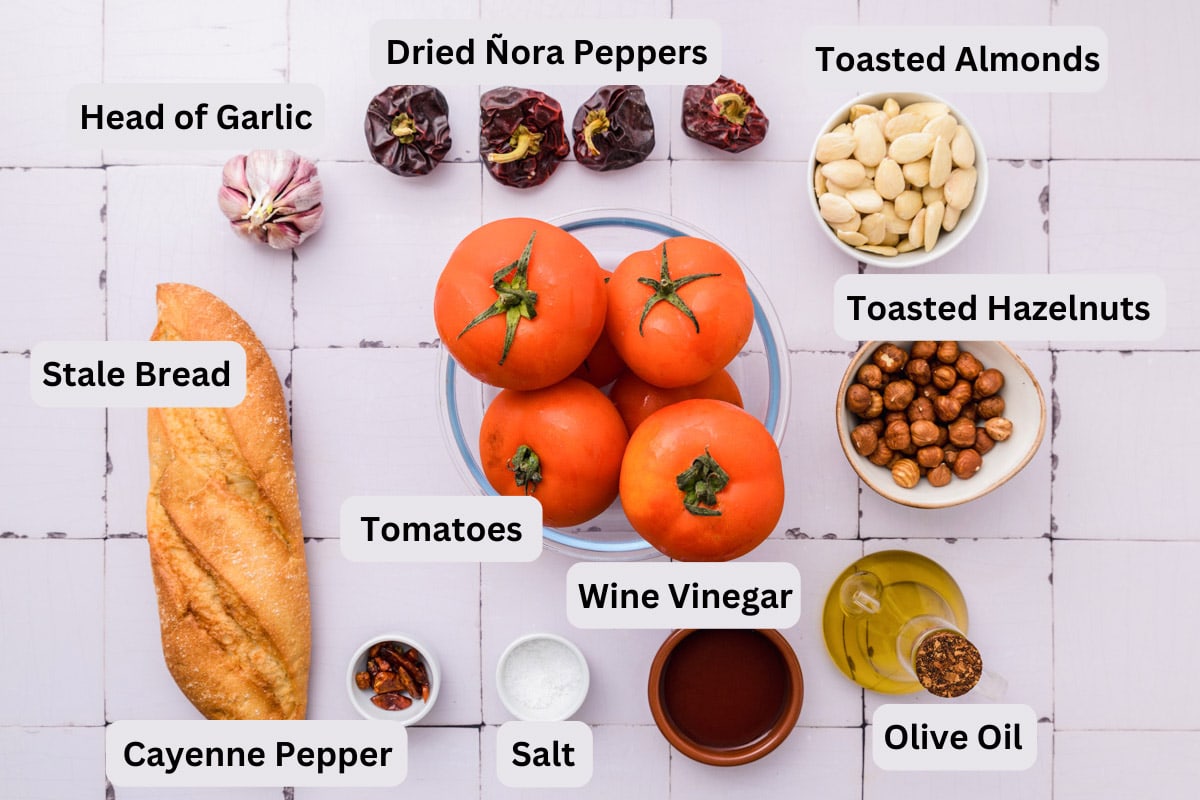
If you want to make this Spanish delight, here are the romesco sauce ingredients that you will need:
- Tomatoes – Any type of tomato will work, but using large ripe tomatoes (the riper the better) will result in a more intense flavor.
- Garlic – A head of garlic.
- Dried ñora peppers – Alternatively, use roasted bell pepper and smoked paprika.
- Stale white bread – Any stale white bread will work. Alternatively, use unflavored croutons.
- Almonds – Preferably use raw almonds without skin and roast them yourself. Alternatively, remove the skin yourself.
- Hazelnuts – Preferably use raw hazelnuts and roast them yourself. Hazelnuts with skin on them are fine.
- Extra virgin olive oil – If you can’t find extra virgin olive oil, a good quality olive oil will do. Avoid using any other oil.
- Wine vinegar – Preferably sherry wine vinegar.
- Cayenne pepper – A cayenne pepper for some heat (not the powder). This is optional
- Salt – Add to taste.
Recipe Tips and Substitutions
Before you make this Romesco sauce recipe, read through these tips and substitutions so that you know what to expect as you create!
- In general, use high-quality ingredients to ensure the best flavor.
- If you use croutons instead of stale bread, you can also use them without frying them first.
- Ñora peppers can be challenging to find outside of Spain. You can still get a very similar flavor with other easy-to-find ingredients. Ñora peppers are dried, sweet, smoked, and slightly bitter. To replicate the flavor, you can roast one small red bell pepper along with the tomatoes and add 1 teaspoon of smoked paprika powder to the seasoning.
- For this recipe, we typically use sherry wine vinegar, but any good quality wine vinegar will work. Avoid using balsamic vinegar as it will drastically change the flavor of the sauce.
- There are versions of Romesco sauce that are not spicy and others that have a slight spicy kick, so feel free to add the cayenne pepper or not.
- Be sure to remove the almond skins, as they can make the sauce too bitter (leaving some is fine). If you have to choose between almonds or hazelnuts, I’d go with almonds – but if you can, add both.
- You can blend the Romesco sauce until it is super smooth or leave it a little chunky, depending on your preference. I prefer an in-between consistency.
How to Make Romesco Sauce – Step by Step Instructions
In this section, we’ll show you exactly how to make this traditional Romesco sauce recipe.
We’ve included recipe process photos so you can see how the recipe is made – and what it is supposed to look like – at each step.
The printable recipe card is at the bottom of this post with more details like ingredient amounts – but no pictures.
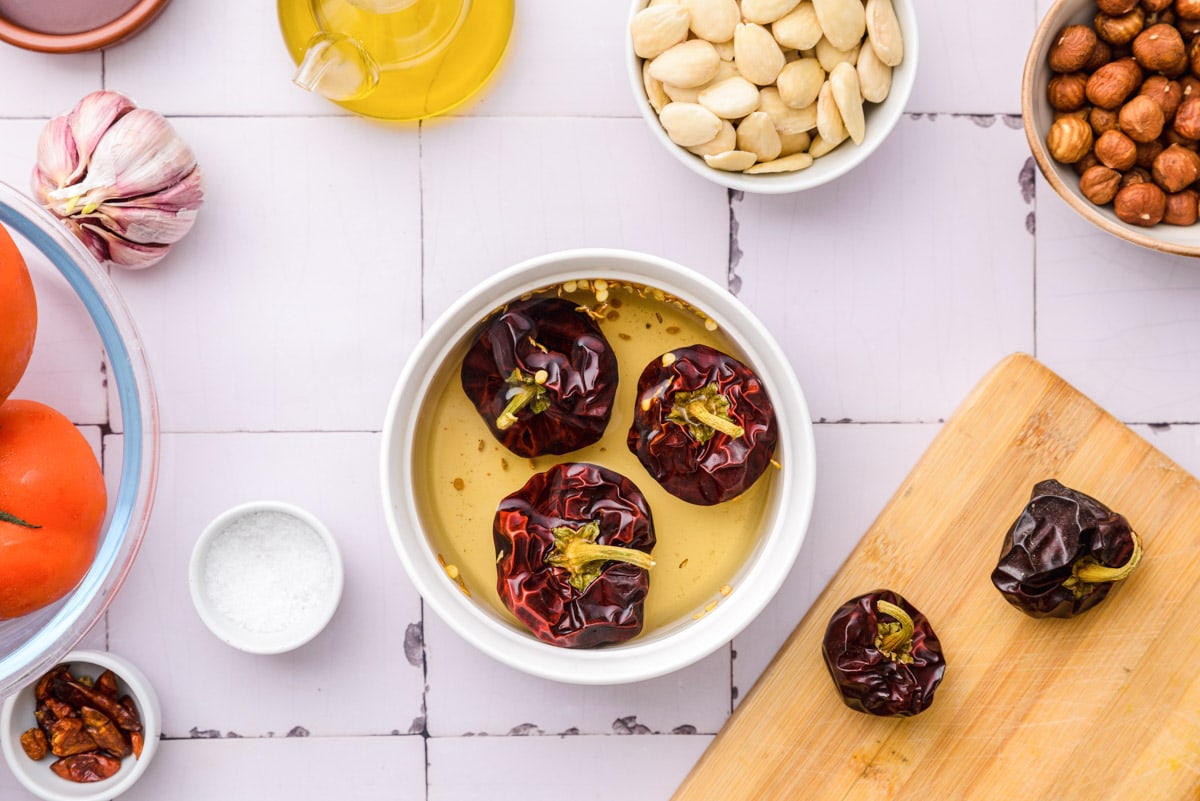
Start by preheating your oven to 375 degrees Fahrenheit.
Make a few tiny cuts in the ñora peppers and add them to a bowl. Cover with hot water, making sure they get filled with it. Set aside.

Wash the tomatoes and place them on a baking sheet along with the head of garlic (wrapped in aluminum foil). Drizzle with olive oil and bake for 30 minutes.
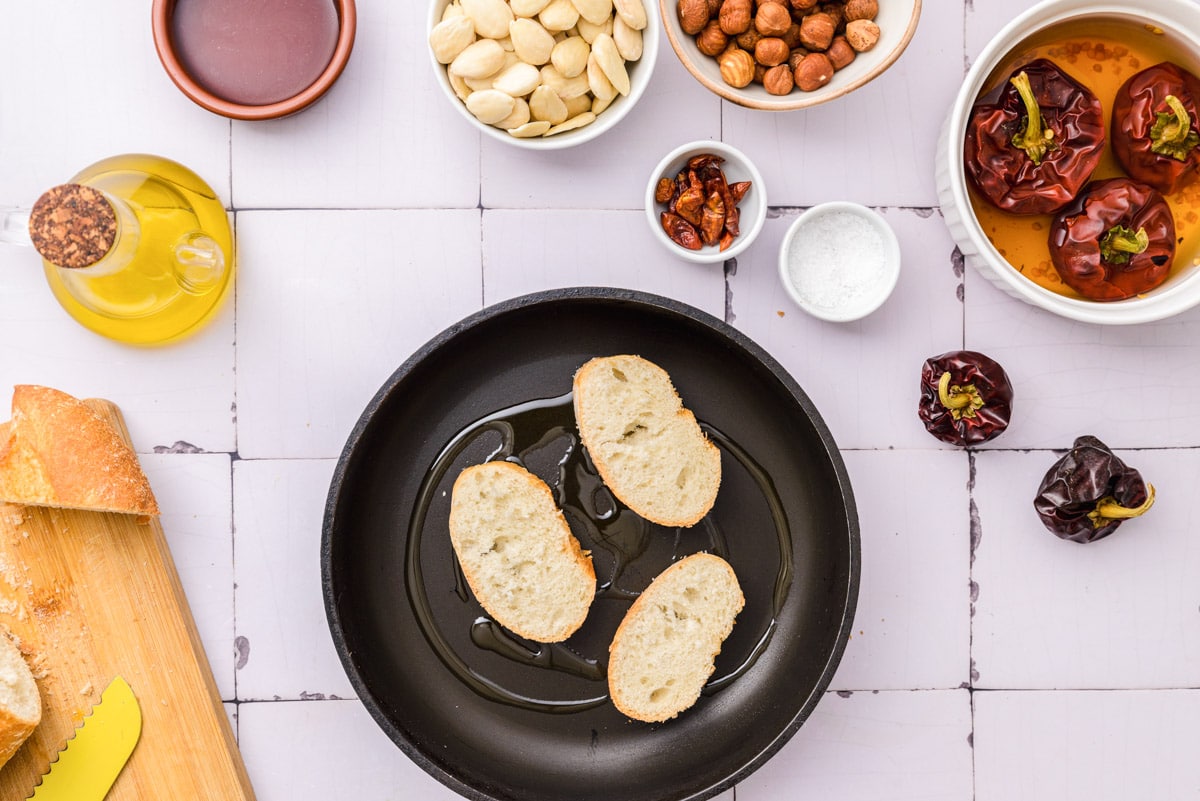
While the tomatoes and garlic are roasting, fry the bread slices.
In a frying pan, heat a drizzle of olive oil.
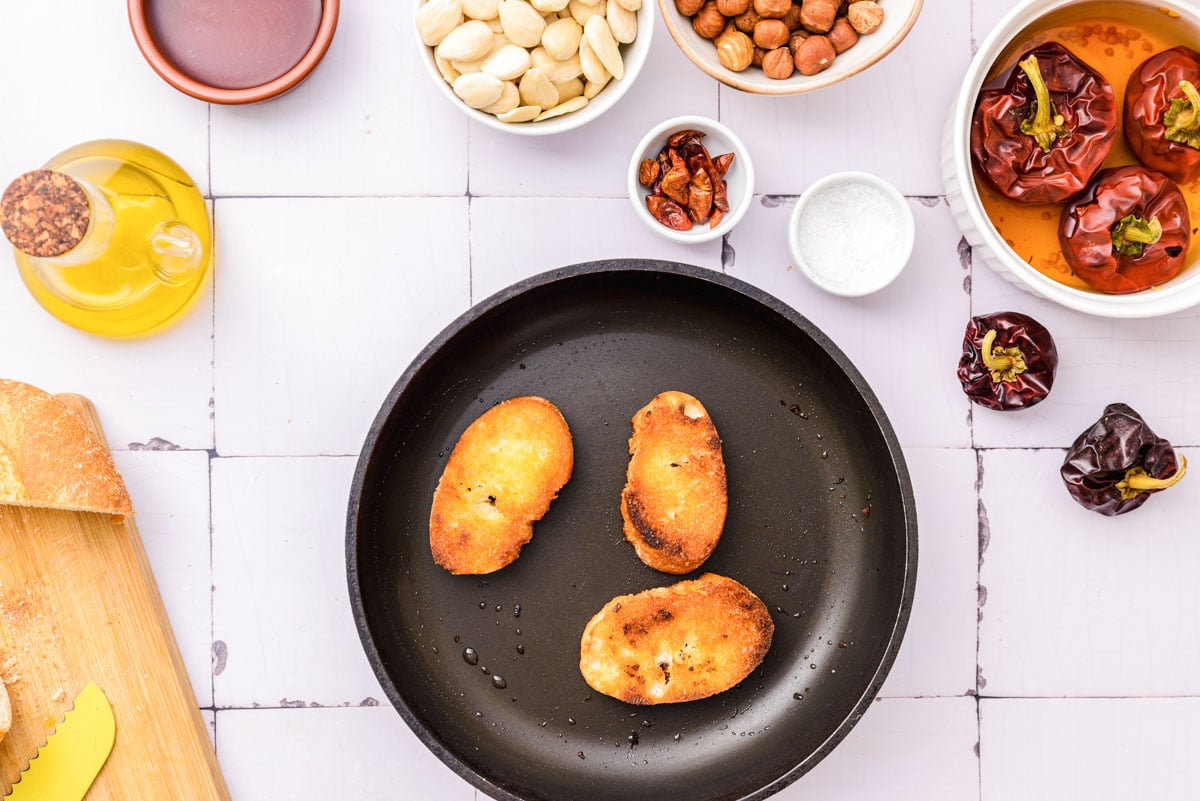
Fry the slices of bread until golden on each side. Set aside.

In the same pan, toast the almonds and hazelnuts for 5-7 minutes, stirring occasionally to make sure they don’t burn.
Once toasted, set them aside to cool. If your almonds still have the skin on, rub them to remove the skin. The hazelnut skins are ok to keep.
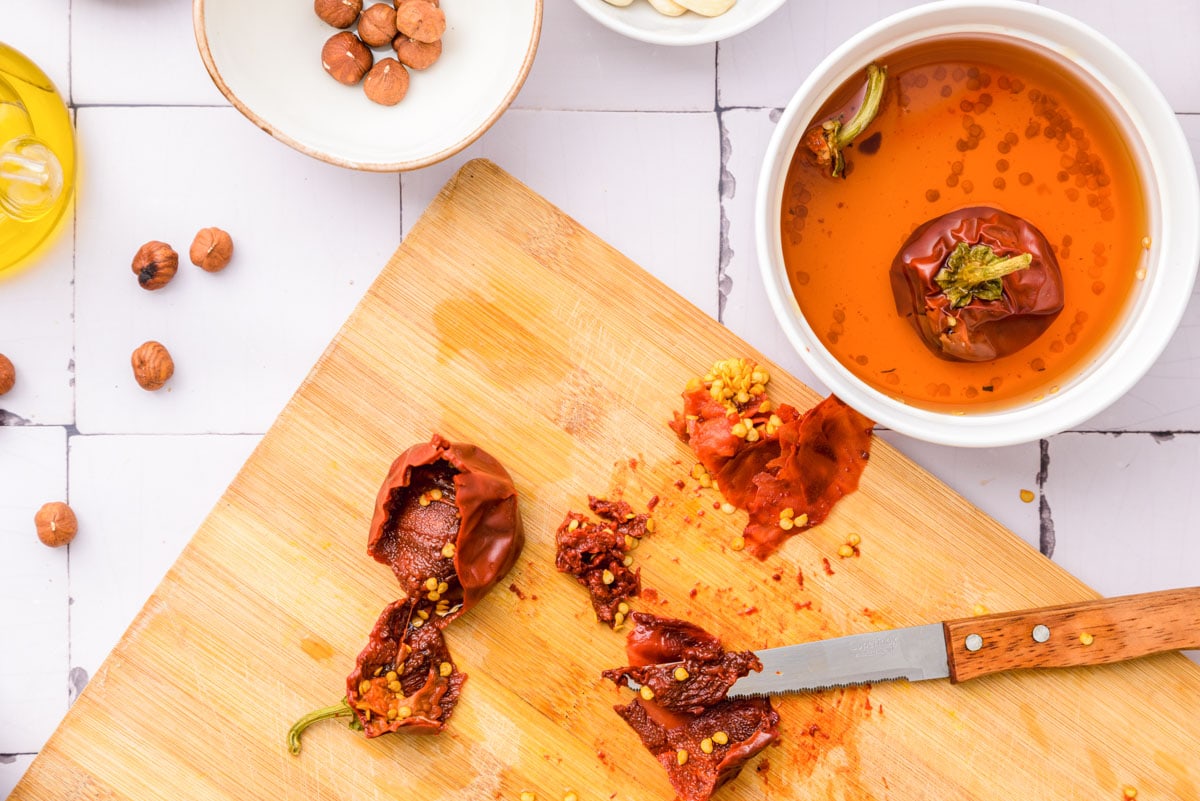
Remove the ñora peppers from the water and place them on a cutting board.
Cut them in half and scrape out the flesh with the help of a knife. Discard the seeds, stem, and skin. Set aside the ñora pepper flesh.
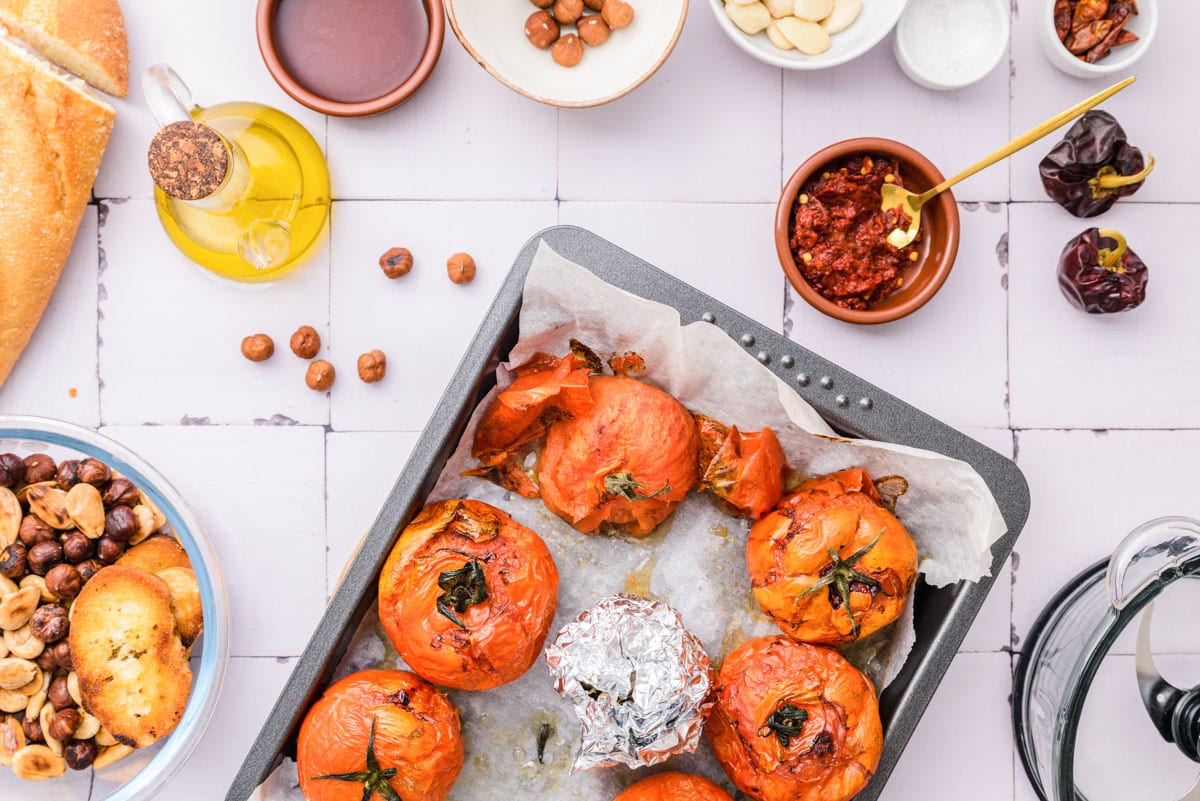
Once the 30 minutes are up, remove the baking sheet from the oven and let the tomatoes and garlic cool for 10 minutes.
Then remove the tomato skins and squeeze out the garlic cloves.

Place the roasted and peeled tomatoes, the roasted garlic cloves, the fried bread, the ñora pepper flesh, the toasted almonds, and the hazelnuts in a food processor.
Process for 2-3 minutes until a thick texture is achieved.

Add the olive oil, wine vinegar, salt, and cayenne pepper and process for an additional minute.
You can process the Romesco sauce until it is super smooth or leave it a little chunky, depending on your preference.
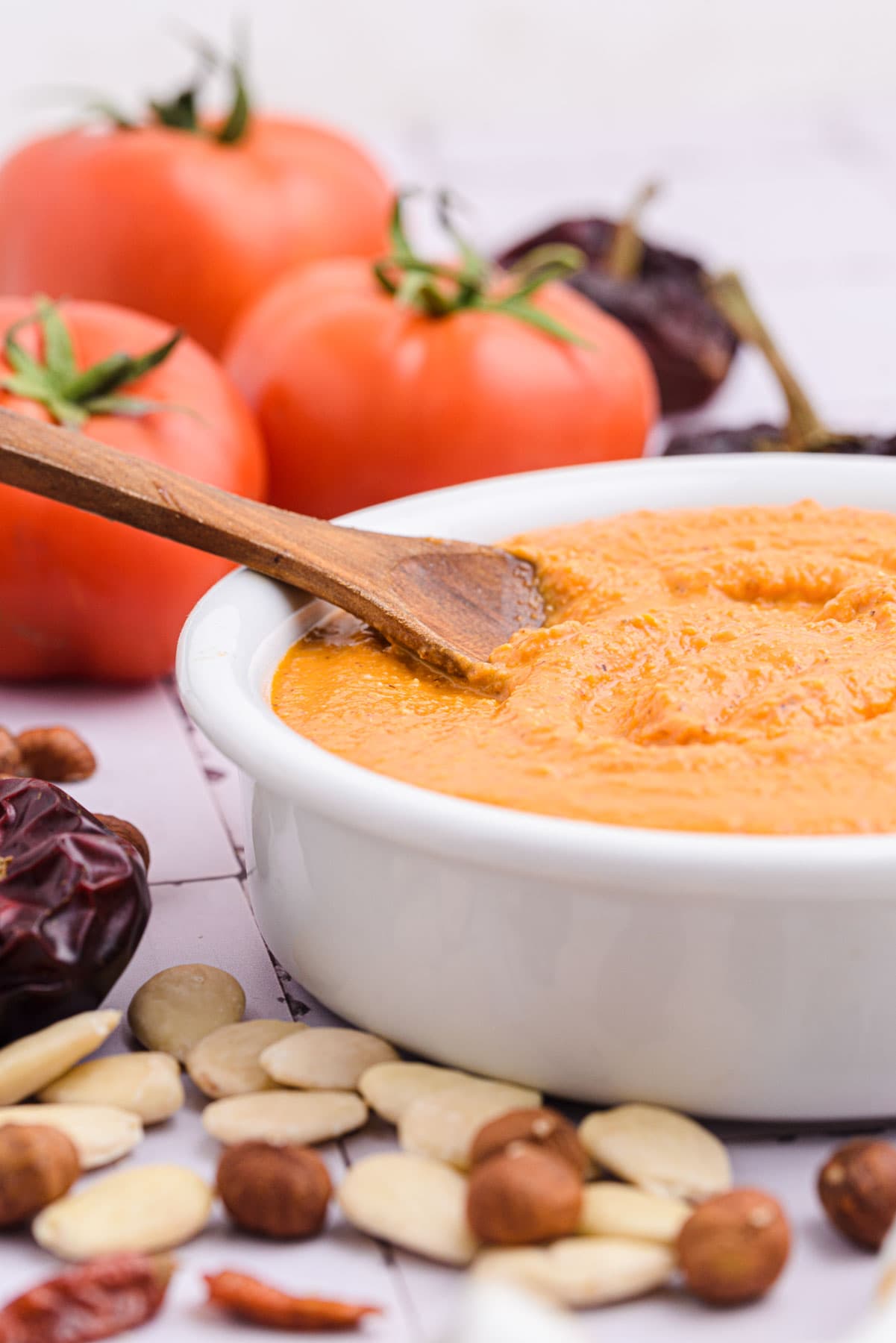
How to Serve Romesco Sauce
You can serve the romesco sauce alongside any meat or fish, as a dipping sauce for roasted veggies, or as a spread on toast (it’s quite good!).
Traditionally, Romesco sauce is eaten with roasted “Calçots”, so roasted leeks or spring onions will go perfectly with this delicious sauce.
Although not traditional, Romesco sauce can also be used as a flavor enhancer for stews and many other dishes. So don’t be shy and add a couple of spoons to your next beef stew for amazing results.
I’ve also tried it with pasta with surprisingly delicious results. Just keep in mind that it contains a bit of wine vinegar, so you’ll need to balance the acidic flavor with other ingredients.
There’s also a dish called “Romescada” which is a delicious fish stew with Romesco sauce.
Storage Tips
Once you’ve made this Romesco sauce, you can store any leftovers in a sealed container in the fridge for up to 5 days.
If you cover the top with a thin layer of olive oil – making sure there’s no sauce exposed to air, it can be stored for a few more days.
You can also portion the sauce into cubes, freeze them, and have them ready to use in your cooking.
FAQ
Here are some answers to questions about this easy Romesco sauce:
Romesco sauce is a thick, earthy, savory sauce that originated in the Cataluña region of Spain. It is made with ripe tomatoes, stale bread, ñora peppers, nuts, and a few other ingredients and spices.
You can eat Romesco sauce with meat, fish, roasted vegetables, as a spread on toast, or as a dip. Romesco sauce can be used in “Romescada”, a type of fish stew with Romesco sauce. Traditionally, Romesco sauce is eaten with roasted “Calçots”, so roasted leeks or spring onions will go perfectly with this delicious sauce.
To make Romesco sauce, roast the vegetables and fry the stale bread in olive oil. Toast the nuts, then combine the ingredients in a food processor and blend until thick but smooth in consistency.
Related Recipes
If you loved this Romesco recipe, here are some more Spanish recipes that you might want to try making:
- Pisto (Vegetable Stew)
- Sopa de Ajo (Spanish Garlic Soup)
- Albóndigas en Salsa (Spanish Meatballs)
- Patatas Bravas
- Salmorejo (Spanish Tomato Soup)

Romesco Sauce
Ingredients
- 35 ounces tomatoes, ripe
- 1 head garlic, approximately 10 cloves
- 3-4 ñora peppers, dried
- 3 slices white bread, stale (about 2 ounces)
- 1/3 cup almonds, skin removed
- 1/4 cup hazelnuts
- 4 tablespoons olive oil, extra virgin; more for cooking
- 1 tablespoon wine vinegar
- 1 small cayenne pepper, optional
- salt, to taste
Instructions
- Preheat the oven to 375 degrees Fahrenheit.
- Make a few tiny cuts in the ñora peppers and add them to a bowl. Cover with hot water, making sure they get filled with it. Set aside.3-4 ñora peppers
- Wash the tomatoes and place them on a baking sheet along with the head of garlic (wrapped in aluminum foil). Drizzle with olive oil and bake for 30 minutes.35 ounces tomatoes, 1 head garlic
- While the tomatoes and garlic are roasting, fry the bread slices. In a frying pan, heat a drizzle of olive oil and fry the slices of bread until golden on each side. Set aside.3 slices white bread
- In the same pan, toast the almonds and hazelnuts for 5-7 minutes, stirring occasionally to ensure they don’t get burned. Once toasted, set aside to cool.1/3 cup almonds, 1/4 cup hazelnuts
- If your almonds still have the skin on, rub them to remove the skin. The hazelnut skins are ok to keep.
- Remove the ñora peppers from the water and place them on a cutting board. Cut them in half and scrape out the flesh with the help of a knife. Discard the seeds, stem, and skin. Set the ñora pepper flesh aside.
- Once the 30 minutes are up, remove the baking sheet from the oven and leave to cool for 10 minutes.
- Remove the tomato skins and squeeze out the garlic cloves.
- In a food processor, add tomatoes, roasted garlic cloves, fried bread, ñora pepper flesh, toasted almonds, and toasted hazelnuts. Process for 2-3 minutes until a thick texture is achieved.
- Add the olive oil, wine vinegar, salt, and cayenne pepper and process for an additional minute. You can process the romesco sauce until it is super smooth or leave it a bit chunky, depending on your preference.4 tablespoons olive oil, 1 tablespoon wine vinegar, 1 small cayenne pepper, salt
- You can serve the romesco sauce with any meat or fish, as a dipping sauce for roasted veggies, as a spread on toast. Traditionally, romesco sauce is eaten with roasted “Calçots”, so roasted leeks or spring onions will go perfectly with this sauce.
Notes
- Use high-quality ingredients for the best flavor.
- If you use croutons instead of stale bread, you can also use them without frying them first.
- Ñora peppers can be difficult to find outside of Spain. To replicate the flavor, you can roast one small red bell pepper alongside the tomatoes and add 1 teaspoon of smoked paprika powder to the seasoning spices.
- Sherry wine vinegar works well for this recipe, but any good quality wine vinegar will do. Avoid using balsamic vinegar since it will drastically change the flavor of the sauce.
- There are versions of Romesco sauce that are not spicy and others that have a slight spice kick, so feel free to add the cayenne pepper or not.
- Be sure to remove the almond skins since they can make the sauce too bitter.
Nutrition
This nutritional information has been estimated by an online nutrition calculator. It should only be seen as a rough calculation and not a replacement for professional dietary advice.
